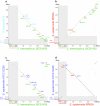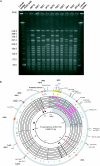Whole-genome sequencing of staphylococcus haemolyticus uncovers the extreme plasticity of its genome and the evolution of human-colonizing staphylococcal species
- PMID: 16237012
- PMCID: PMC1272970
- DOI: 10.1128/JB.187.21.7292-7308.2005
Whole-genome sequencing of staphylococcus haemolyticus uncovers the extreme plasticity of its genome and the evolution of human-colonizing staphylococcal species
Abstract
Staphylococcus haemolyticus is an opportunistic bacterial pathogen that colonizes human skin and is remarkable for its highly antibiotic-resistant phenotype. We determined the complete genome sequence of S.haemolyticus to better understand its pathogenicity and evolutionary relatedness to the other staphylococcal species. A large proportion of the open reading frames in the genomes of S.haemolyticus, Staphylococcus aureus, and Staphylococcus epidermidis were conserved in their sequence and order on the chromosome. We identified a region of the bacterial chromosome just downstream of the origin of replication that showed little homology among the species but was conserved among strains within a species. This novel region, designated the "oriC environ," likely contributes to the evolution and differentiation of the staphylococcal species, since it was enriched for species-specific nonessential genes that contribute to the biological features of each staphylococcal species. A comparative analysis of the genomes of S.haemolyticus, S.aureus, and S.epidermidis elucidated differences in their biological and genetic characteristics and pathogenic potentials. We identified as many as 82 insertion sequences in the S.haemolyticus chromosome that probably mediated frequent genomic rearrangements, resulting in phenotypic diversification of the strain. Such rearrangements could have brought genomic plasticity to this species and contributed to its acquisition of antibiotic resistance.
Figures





References
-
- Altschul, S. F., W. Gish, W. Miller, E. W. Myers, and D. J. Lipman. 1990. Basic local alignment search tool. J. Mol. Biol. 215:403-410. - PubMed
-
- Baba, T., F. Takeuchi, M. Kuroda, T. Ito, H. Yuzawa, and K. Hiramatsu. 2004. The Staphylococcus aureus genome, p. 66-153. In D. Ala'Aladeen and K. Hiramatsu (ed.), Staphylococcus aureus—-molecular and clinical aspects. Harwood Publishing Limited, Chichester, United Kingdom.
-
- Baba, T., F. Takeuchi, M. Kuroda, H. Yuzawa, K. Aoki, A. Oguchi, Y. Nagai, N. Iwama, K. Asano, T. Naimi, H. Kuroda, L. Cui, K. Yamamoto, and K. Hiramatsu. 2002. Genome and virulence determinants of high virulence community-acquired MRSA. Lancet 359:1819-1827. - PubMed
-
- Bergey, D. H., and J. G. Holt. 1994. Bergey's manual of determinative bacteriology, 9th ed. Williams & Wilkins, Baltimore, Md.
-
- Centers for Disease Control and Prevention. 1999. Four pediatric deaths from community-acquired methicillin-resistant Staphylococcus aureus--Minnesota and North Dakota, 1997-1999. JAMA 282:1123-1125. - PubMed
Publication types
MeSH terms
Substances
Associated data
- Actions
- Actions
- Actions
- Actions
Grants and funding
LinkOut - more resources
Full Text Sources
Other Literature Sources
Molecular Biology Databases

